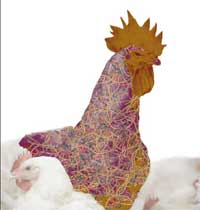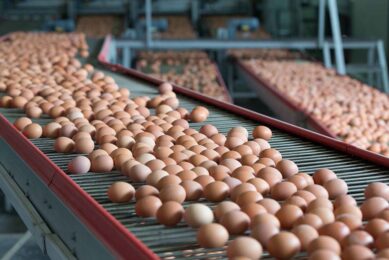Poultry breeding – the next 25 years

For decades, poultry breeding has been a permanent matter of improving efficiency – reaching higher yields at lower cost – in terms of both eggs and meat. Has the limit been reached, or is progress still possible in the next 25 years? In this article, a geneticist gives his view on the poultry industry in 2034.
By Prof Dietmar K. Flock, Cuxhaven, Germany
Asked today how I see the next 25 years of the egg and poultry meat industry, I could make a long story short by referring the reader to an article published in World Poultry (Vol. 15, No. 6) in which the previous Editor Wiebe van der Sluis presented what I thought I knew then under the title “Is the loss of genetic variation threatening the poultry industry?”. Since then, I have been watching genetic progress and changes in the industry, and I still feel confident that the poultry industry will continue to adapt successfully to changing requirements.
Predicting progress
Forty years ago when I started as a geneticist in the poultry industry, we spent considerable time trying to estimate annual genetic progress. Based on the selection practised and comparisons between two successive generations involving “repeat mating controls”, we predicted annual progress of 3-4 eggs per hen housed. We discontinued reproducing unselected controls after I had convinced myself that the response was similar to predictions from the selection differentials and random sample test results were providing more relevant comparisons: rates of progress in different strain crosses. Today, rates of progress are estimated routinely for individual traits before each selection by special computer software. This enables geneticists to fine-tune the selection index for each line according to current breeding goals.
Applied genetics is not a “black box” with uncertain results. Within narrow limits, rates of progress can be predicted and verified under field conditions with a time lag of a few years, depending on the number of generations or multiplications between selection of elite pedigree stock and production of the commercial cross.
Laying hens
The general breeding goals for laying hens are essentially the same as 10 years ago, and I expect they will remain similar during the next 25 years: high number of saleable eggs per hen housed in a laying cycle of optimum length, efficient feed conversion, persistent external and internal egg quality, low mortality, and adaptability to commercial environments. Efficient feed conversion will receive even more attention than in the past as a result of high feed prices due to the use of grain for bio-energy production. Adaptability to floor management involves several traits that are difficult to measure, requiring specially designed testing facilities for traits like nesting behaviour, feather pecking and cannibalism.
Progress in rate of lay and feed efficiency is illustrated in Figure 1, and is based on results of a comparable strain cross of White Leghorns from official German random sample tests in Haus Düsse in 1980 and 2004. Since early sexual maturity (age at first egg) is negatively correlated with egg size, persistency and annual egg income over feed cost, we have focused on rate of lay in the second half of the laying period. Well managed flocks today peak around 97%, maintain 90% throughout the first year of lay, and can be kept to at least 80 weeks.
As a result of improved persistency of egg production and shell quality, it will become possible to produce 400+ eggs in a single laying cycle instead of molting – a practice not accepted by poultry welfare standards in many countries. Genetic selection to minimise feed cost per egg or per kg egg mass will continue, based on individual consumption per hen during a limited testing period after peak production. The rations fed during these tests will be close to commercial layer mash and vary depending on the availability and price of components. Persistency of feather cover will be added as a correlated trait.
Molecular genetics techniques demonstrate their potential usefulness in identifying the FMO3 gene and eliminating the fishy odour of some brown-shelled eggs. The search for single genes explaining a major part of the variation in specific traits will continue, and genomic selection will become standard practice.
Broilers
After five decades of continuous reduction of age at market weight by about one day per year, with correlated improvements in feed efficiency and livability, it became obvious in the 1970s that further progress had to come from a more sophisticated breeding approach. Negative correlations between juvenile weight gain and reproductive performance were overcome by developing specialised male and female lines and sex-separate, controlled feeding. Additional traits were included in the selection indices, with different emphasis in male and female lines on weight for age, feed conversion, and meatiness among other traits.
The focus of primary breeders shifted over the past 25 years from integrated live broiler production (efficient production of day-old chicks and live broilers) to the demands of processing plants (meat yield and product quality). Measuring individual feed consumption and selecting for weight gain minus feed cost had several positive effects: selection intensity on weight for age was relaxed, feed cost per unit live weight gain reduced, yield of lean meat increased, and abdominal fat reduced.
Meat yield improvement in today’s broilers compared to an unselected control line is spectacular (Figure 2). There is no reason to assume that the limit in lean meat gain has already been achieved. In the next 25 years we will see broilers grown to higher final weights to harvest the full potential for efficient weight gain, enabling the further processing industry to extend the line of their products.
Less spectacular are the results of selection for better leg health in rapidly growing broilers and more efficient reproduction of broiler parents – two traits that appear to be negatively correlated with rapid juvenile growth rate and meat yield. We can expect that efforts to improve these traits will continue with appropriate intensity to maximise overall efficiency of broiler meat production. If broilers are grown to higher final weights, chick cost will become relatively less important, but livability and leg health more important.
Turkeys
Worldwide turkey production is currently estimated at 5 million mt, compared to 70 million mt for broilers. Superficially, turkey breeding resembles broiler breeding, and the breeding objective is essentially the same: efficient production of poultry meat. We also find the same hierarchical structure of the industry, with few primary breeders supplying parents of specialised sire and dam lines to distributors worldwide. Turkeys, however, differ in several ways from broilers, leading to different emphasis in the breeding programmes: artificial insemination is commonly used; adult breeders do not require restricted feeding to control excess appetite; and, turkeys are grown sex-separate to different ages to minimise production cost for the final weights dictated by market requirements for special products.
Compared to broilers, turkeys are grown much longer to make use of their growth potential, which explains their less efficient feed conversion. Aggressiveness and leg problems and can cause high mortality of male turkeys toward the end of the growing period, making it expensive and risky for the turkey grower to produce the high final weights preferred by processors. Future genetic development will therefore focus on growth rate or time to market weight, feed efficiency, livability, reduced leg problems, and improved hatchability. Turkey breeding is more expensive than broiler breeding in terms of cost per bird kept at a pedigree level and relative to the potential sales volume of parents. Unless primary breeding companies invest relatively more in turkey than broiler development, I expect slower progress in turkeys than in broilers. This could actually be an advantage in the very long run, provided the turkey industry remains profitable in the meantime. Selection theory tells us that upper limits of performance are maximised at selection intensities around 50%, which is much lower than current practice in broiler breeding.
Continued improvements
I expect that the genetic potential for efficient poultry meat and egg production will continue to be improved at rates competitive with other sources of animal protein for human consumption. There is no danger that genetic variation will be exhausted within the next 25 years in the large base populations of current commercial crosses. The leading primary breeders have a large gene pool to choose from and will also be able to offer special products for niche markets. Genomic selection will be applied to generate additional progress in traits that cannot be measured with conventional methods. The tendency to overproduce is likely to continue on a global level, and so producers will remain under pressure to cut costs to stay in business, while consumers can choose from a wide range of poultry products as “best value for money”.
The development toward ever more efficient production of poultry meat and eggs will contribute toward minimising greenhouse gases from animal production, but it does not help small family farms in developing countries that experience international trade with cheap food as a threat to their modest source of family income.
Join 31,000+ subscribers
Subscribe to our newsletter to stay updated about all the need-to-know content in the poultry sector, three times a week. Beheer
Beheer








 WP Admin
WP Admin  Bewerk bericht
Bewerk bericht